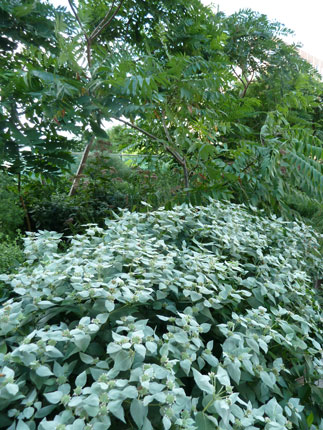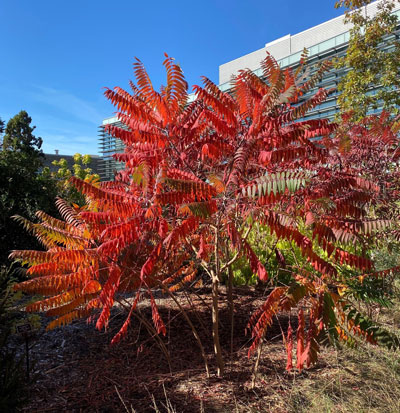3/1/2025
Solutions for Banks & Slopes
Andrew Bunting

In the garden and landscape at large, there are many areas that for a variety of reasons are challenging to establish effective landscaping on. Arguably the biggest challenge is finding plants that can thrive on banks and slopes.
Often, the general condition and nature of banks and slopes can make it difficult to even establish a lawn. Fortunately, there are many colonizing shrubs and perennials that can cover banks and slopes with ease and withstand the often harsh and challenging environmental conditions they present, including poor quality and eroding soils, and dry conditions exacerbated by reflected heat.
Pictured: The hakone grass, Hakonechloa macra, is a quick-spreading option for shady areas.
Consider These Native Shrubs
The Virginia sweetspire (Itea virginica) is a great colonizing shrub for banks and slopes. This deciduous shrub spreads relatively quickly by underground stems, forming a dense thicket over time. This multi-season shrub is hardy to USDA Zones 5 to 9. In the spring it’s covered in very fragrant, white, bottlebrush-like flowers. The fall color can range from orange, red or yellow with the best selections having a deep maroon-purple fall color. Outstanding selections include Henry’s Garnet, with deep purple fall color that reaches 3 to 5 ft. at maturity. A more diminutive selection is Little Henry and Merlot also has excellent fall color.
 Clethra alnifolia, common name summersweet, is another native spreading shrub. It’s aptly named for its sweetly fragrant flowers in late summer that bloom in abundance, with tubular clusters of flowers covering the medium-sized shrub. Over the years, several excellent selections have been made. Hummingbird is a diminutive cultivar only reaching about 3-ft. tall at maturity. Ruby Spice has soft pink flowers and is recognized as a top ornamental shrub with the Gold Medal designation by the Pennsylvania Horticultural Society. Sixteen Candles is a compact and floriferous selection by famed plantsman Dr. Michael Dirr. Like Hummingbird, Sugartina is grown for its smaller stature. In the fall, the narrow leaves turn bright golden yellow. In the landscape, the summersweets are also very tolerant of poorly drained sites and wet soils.
Clethra alnifolia, common name summersweet, is another native spreading shrub. It’s aptly named for its sweetly fragrant flowers in late summer that bloom in abundance, with tubular clusters of flowers covering the medium-sized shrub. Over the years, several excellent selections have been made. Hummingbird is a diminutive cultivar only reaching about 3-ft. tall at maturity. Ruby Spice has soft pink flowers and is recognized as a top ornamental shrub with the Gold Medal designation by the Pennsylvania Horticultural Society. Sixteen Candles is a compact and floriferous selection by famed plantsman Dr. Michael Dirr. Like Hummingbird, Sugartina is grown for its smaller stature. In the fall, the narrow leaves turn bright golden yellow. In the landscape, the summersweets are also very tolerant of poorly drained sites and wet soils.
Pictured: Pycnanthemum muticum reaches 3-ft. tall at maturity and is a pollinator powerhouse.
There are many species and selections of native sumacs that can be considered for sloping conditions. In addition to being excellent colonizing shrubs, they’re all resistant to deer, as well. The fragrant sumac Rhus aromatica Gro-low is a very popular plant for covering difficult sites. This low-growing groundcover selection quickly clambers over the ground. In addition to being an exceptional groundcover, it’s grown for excellent fall color, which can range from yellow to orange. Larger in stature is both Rhus glabra (smooth sumac) and Rhus typhina (staghorn sumac). Reaching 10 to 15 ft. at maturity, both sumacs bring interesting architecture to the garden and their large compound leaves also add a fine texture. In the fall, they have excellent color, ranging from orange to red. They produce large upright clusters of fruits that turn burgundy in the late summer into the fall and are an excellent food source for native birds. Laciniata is a selection of the staghorn sumac with leaves that are incised and Tiger Eyes has brilliant chartreuse foliage in the summer, which turns orange in the fall.
The bush honeysuckle (Diervilla sessilifolia) is a quick spreading, medium-sized shrub reaching 3- to 5-ft. tall at maturity. In early summer it has upright tight clusters of tubular yellow flowers that attract many pollinators, including hummingbirds. This honeysuckle relative is a good substitute for many of the exotic and invasive honeysuckles, including Lonicera maackii and Lonicera fragrantissima. Kodiak Orange is a selection that has hints of orange in the emerging foliage and excellent orange-red fall colors. Diervilla has exhibited good deer resistance.
The bayberry (Myrica pensylvanica) is a very versatile shrub. This deciduous shrub is extremely cold hardy. Over time it can reach over 10-ft. tall, but with some selective pruning the height of the plant can be reduced. Both the stems and leaves are bay leaf scented, deterring deer from browsing. Bayberry has both male and female plants. Along the branches of the female, clusters of smokey white fruits will develop and last most of the winter. Myrica is a good food source for birds. They’re also fairly tolerant of salt spray.
Tough Perennials
In recent years, many of the mountain mints, (pycnanthemum) have grown in popularity due to their ease of cultivation, resistance to deer and their amazing ability to attract a diverse host of pollinating insects and bees. Pycnanthemum muticum is extremely quick to colonize in the garden, making it a good choice for banks and slopes, as well. At maturity, it reaches 3-ft. tall, with flowers that are surrounded by very attractive silver-white bracts. The lavender flowers themselves are very small and somewhat inconspicuous, however, these tiny flowers are “magnets” for an amazing diversity of pollinators. As the common name would suggest, the leaves have a minty fragrance and can truly be classified as deer resistant.
A great ground-hugging perennial is Robin’s fleabane, Erigeron pulchellus var. pulchellus Lynnhaven Carpet. The fuzzy gray-green leaves and stems quickly form a thick mat. Flower stems rise about 12 in. above the foliage and the daisy-like flowers have soft lavender petals with a yellow center. Lynnhaven Carpet can tolerate some shade, but thrives best in sun.
 Pictured: Rhus glabra is a great architectural piece in the garden, and shows off in the fall with orange and red hues.
Pictured: Rhus glabra is a great architectural piece in the garden, and shows off in the fall with orange and red hues.
There are also many ornamental grasses that will thrive on sloped landscape conditions. A native of the prairies, the switchgrass Panicum virgatum is extremely durable. The clump-forming grass will spread over time and, depending on the cultivar, the upright narrow leaves will reach 3- to 6-ft. tall, with fine textured flowers and seed heads on top of its foliage. Over the past 25 years many outstanding cultivars of switchgrass have risen to prominence. Northwind has blue-green foliage during the summer turning gold in the fall. Cheyenne Sky and Shenandoah have purple autumnal colors.
Shady Perennials
For shady conditions on banks and slopes, there are many excellent perennials to consider as well. The Christmas fern (Polystichum acrostichoides) grows on wooded slopes in natural settings, and is evergreen and clump-forming. It produces upright, leather, dark green fronds. Like all other ferns, it’s also deer resistant.
The hakone grass (Hakonechloa macra) is another quick-spreading ornamental grass for shady areas. This massing grass produces elegant, narrow arching leaves that reach up to 2-ft. tall. While most ornamental grasses prefer growing in full sun, the hakone grass thrives in the shade. In the fall it turns hues of gold and in the winter turns an attractive tawny color.
While slopes and banks are one of the toughest places to landscape, thankfully there are a host of outstanding shrubs and perennials, including ferns and grasses, that can thrive in this type of environment while adding ornament, aesthetic value and functionality in this area of the garden. GP
Andrew Bunting is the Vice President of Horticulture for the Pennsylvania Horticultural Society (PHS), which uses horticulture to advance the health and well-being of the Greater Philadelphia region. To learn more about PHS, or to become a member and support greening initiatives in over
250 neighborhoods, visit PHSonline.org.